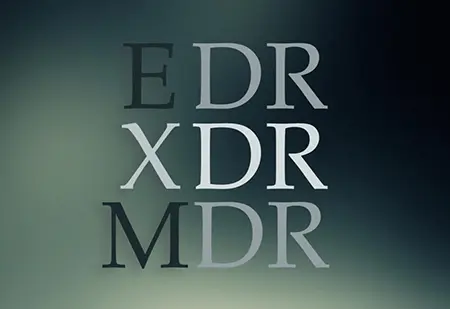Cybercrime is increasing faster than ever, and many nations are struggling with the security/protection of the risk involved. With increasing cyber attacks, cyber experts are constantly developing new tools to protect networks from hacking attacks. Although this technological evolution brings major advantages, cybersecurity still needs to be clarified for the normal person.
Now the question arrives, how do you know what type of protection will suit you the best without spending time learning a new process? There is a variety of products available to provide essential security. Some of the most common include endpoint detection and response (EDR), managed detection and response (MDR) and extended detection and response (XDR).
Every system is different in terms of the security and solution it provides. To better understand and determine what type of protection is best for your company, let's look at each system.
EDR- ENDPOINT DETECTION AND RESPONSE
EDR is a cybersecurity solution that detects and responds to threats across various network components. It uses data analytics to identify and trace potential threats, block suspicious activity, and provide repair suggestions. An endpoint is a device that connects to any device over a computer network, such as laptops, tablets, smartphones, and IoT devices. They are easily accessible by malware if left unprotected since these devices communicate across the network.

It has become easier for hackers to target endpoints with the evolution of new ways for computers and other smart devices. This is the major reason to ensure endpoint security that detects threatening behaviour and calls for repairable action before any threat occurs.
Functionality of EDR
To defend against threat activities, EDR emphasizes continuous monitoring and threat detection on a priority basis and generates threat responses on every endpoint.
EDR must have the following capabilities:- Investigate security events
- Detect security events
- Provide the incident at the endpoint
- Provide solution guidance
When suspicious behaviour is captured, the EDR system calls out an alert immediately to specified professionals. Based on the warning, the system restricts the activity, removes the threat, and restores any damage. For example, as soon as the system detects a threat, it generates an alert and launches an automated response to detach the affected endpoint from the rest of the system. This is where human intervention is important to examine what should be done next.
The role of data analysts starts here, and they investigate the threat to know how the breach has occurred. A valuable part of the investigation is the data collected by your EDR system. Since EDR is designed to protect endpoint devices, it should be used in addition to other cybersecurity tools. Technically, EDR is an evolution of traditional antivirus software with the added benefit of learned behaviour to recognize emerging threats.
MDR- MANAGED DETECTION AND RESPONSE
MDR is a cybersecurity service that utilizes various cybersecurity tools and provides complete network coverage. These services are usually provided by a managed security service provider (MSSP). MDR Security provides around-the-clock access to cybersecurity experts that delivers scalable cybersecurity solutions. They successfully combine technology's fastening response with human mediation's intuition.
Functionality of MDR
MDR is a service and works differently from both EDR and XDR. This service starts with an investigation of a company's existing security behaviour and potential issues about future attacks and threats. MDR vendors scale solutions to your organization, manage software, and deploy technology to meet human needs. MDR utilizes additional solutions to achieve visibility over a client's entire system. As a result, the external security teams review and validate events to reduce all negatives.
For organizations with budget and staff unavailability, MDR can help build an internal security operations centre on their own. It provides ease from the task of continuous detection and response to the companies. Since not every detection and response procedure will keep an eye on customers' infrastructure, you need to research thoroughly in choosing a better provider.
XDR- EXTENDED DETECTION AND RESPONSE
Extended Detection and Response (XDR) is creating a buzz because it has covered the shortcomings of MDR and EDR. Extensive security is required to protect all network routes, including endpoints, web, cloud applications, and SaaS. XDR is an efficient tool that encloses various types of detection over multiple security areas. XDR ensures protection by automatically gathering and verifying the data from more than one component. It places all security devices within the same platform.
XDR security is an alternative approach to EDR that provides only layered or shallow visibility of threats and attacks. But just like EDR, XDR generates alerts and threat responses to further help in the investigation. XDR extends the capabilities of EDR beyond endpoints and is taken to an organization's application suites and cloud-native platforms.
Functionality of XDR
XDR solutions carry out a reactive approach to threat detection and response. It facilitates visibility across all networks, cloud data, and endpoints. It also applies analytics to address today's increasingly advanced and polished threats. With XDR, security personnel can track threats across any location or source within the organization.
From a business point of view, XDR platforms help companies to focus on strategic priorities ensuring their data and applications are safe and protected. Thus, it's necessary to incorporate XDR to prevent cyber crimes and strengthen security processes.
To Sum UpAfter learning the comprehensive differences between EDR, MDR, and XDR, you might have understood what each system does and how it operates. Like others, each system collects data, generates an alert, and uses it to detect threats. They are capable of generating automated responses on the grounds of data being input and AI learning. But again, many considerable differences set each solution unique and apart from the rest. EDR tools must be combined with additional tools to secure other important network parts. XDR can be installed and utilized to protect a variety of components. On the other hand, MDR analyzes data and responds promptly to active and future threats.